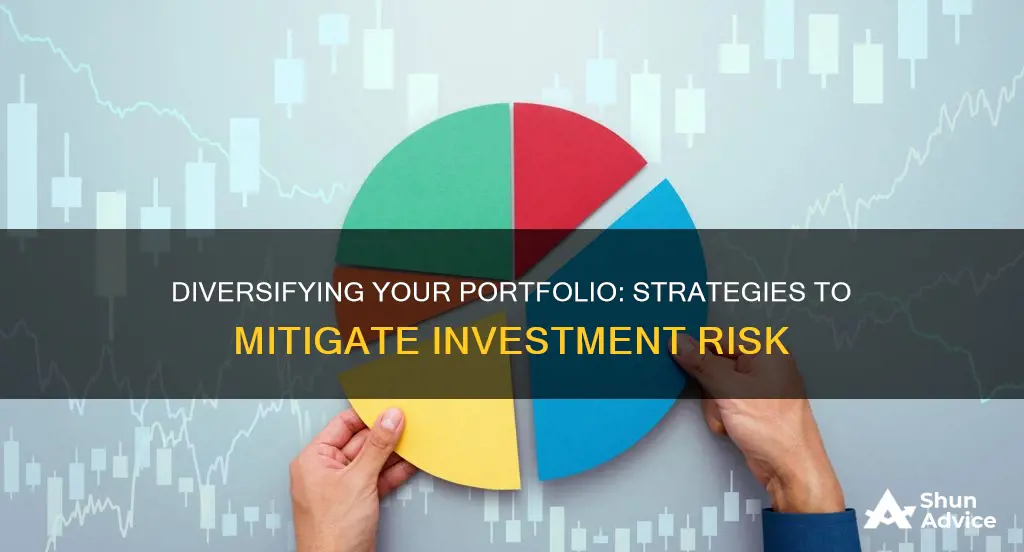
Spreading investment risk is a crucial aspect of any investment strategy, helping to minimise potential losses and maximise gains. By diversifying investments across different categories, regions, sectors, and timing, investors can reduce their exposure to specific risks and take advantage of various opportunities. This approach smooths out the peaks and troughs in investment value development, reducing the severity of outliers.
For example, by investing in a range of asset classes, such as stocks, bonds, and cash, investors can benefit from the fact that these categories often move independently during market shifts. As a result, a decline in one asset class may be offset by gains in another. Additionally, investing in different countries and continents helps to reduce the impact of regional economic downturns or industry-specific challenges.
Another strategy is to invest in a variety of business sectors. For instance, rather than solely focusing on oil-related companies, an investor could diversify their portfolio to include industries like technology, finance, or healthcare. This approach reduces the vulnerability to losses in any one sector.
Furthermore, spreading investments over time, through strategies like periodic investing, helps to average out the purchase price and reduce the impact of short-term market volatility. This long-term approach increases the likelihood of achieving the expected returns.
Overall, by adopting these risk-spreading strategies, investors can improve the stability and resilience of their investment portfolios, minimising potential losses while maximising the potential for gains.
| Characteristics | Values |
|---|---|
| Investment categories | Shares, ETFs, equity funds, bond funds, mixed funds |
| Regions | Different countries and continents |
| Business sectors | Oil, finance, real estate, etc. |
| Buying | Different times over one or several years |
| Time | Longer period of time |
What You'll Learn

Spread investment across different categories
Spreading your investments across different categories is a great way to reduce risk and improve your portfolio's performance. Here are some ways to do this:
- Invest in different sectors: Diversify your portfolio by investing in a variety of sectors rather than just one or two. For example, instead of only investing in oil companies, consider investing in a range of sectors such as technology, healthcare, or finance. This reduces your vulnerability to losses in any one industry.
- Select a diverse range of stocks: Choose a range of stocks from different sectors and with different risk profiles. A good rule of thumb is to select around 10-15 stocks for your portfolio, focusing on companies that are fundamentally strong, have good long-term growth prospects, and that you understand well.
- Invest in different types of assets: Include a mix of stocks, bonds, ETFs, equity funds, and mixed funds in your portfolio. This ensures that you are not overly exposed to the risks of any one type of asset. For example, if stock prices fall, you still have the relative safety of your bond investments.
- Invest in different regions: Buying investments from different countries and continents will reduce your risk if one particular country or region experiences an economic downturn. For example, if you only invest in US stocks, your portfolio will be vulnerable to a US economic recession. By investing globally, you can take advantage of the growth potential of emerging markets while also benefiting from the stability of more developed markets.
- Use investment funds and/or ETFs: These investment vehicles allow you to invest in multiple stocks or bonds within a single fund, providing instant diversification. They are a great way to ensure your portfolio is well-spread and reduce the time and effort required to build a diverse portfolio yourself.
Investment Advisors: India's SEBI-Registered Professionals Count
You may want to see also

Invest in different countries and continents
Investing in different countries and continents is a great way to spread investment risk. By diversifying your portfolio across multiple countries and continents, you reduce your vulnerability to economic, political, and business risks that are unique to a specific country or region.
When investing across different countries and continents, it is important to consider the riskiness of the investment climate in each country. Country risk refers to the uncertainty associated with investing in a particular country, including political, economic, and sovereign default risk. Generally, countries can be categorized into three levels of development: frontier, emerging, and developed markets, with decreasing levels of risk accordingly. Frontier markets, such as Nigeria, Botswana, and Kuwait, are the riskiest but offer the potential for above-average returns. On the other hand, developed markets like the United States, Canada, and Japan are considered the safest investment destinations but often have lower economic growth rates.
It is also essential to assess the economic and political stability of each country before investing. A country with stable finances and a strong economy, such as Singapore, generally provides more reliable investments. Additionally, consider the political climate and its impact on foreign investors. Even if a country has a strong economy, an unfriendly political climate towards outside investors may make it a less attractive investment option.
When investing across continents, it is worth noting that different continents may offer varying levels of risk and return. For example, North America, Europe, and Asia tend to be home to many developed markets with stable economies and lower risk. On the other hand, South America, Africa, and certain parts of Asia may present higher-risk investments but also offer the potential for higher returns.
By investing in different countries and continents, you can reduce the impact of country-specific or regional risks on your portfolio. This strategy helps to ensure that your investments are not overly exposed to the performance of a single country or region, thus providing a more balanced and secure investment approach.
Amazon's Indian Investment: Strategic Business Move
You may want to see also

Buy investments from different business sectors
Diversifying your portfolio by buying investments from different business sectors is a great way to spread investment risk. This strategy ensures that you are not vulnerable to losses in any one particular industry or sector.
For example, if you only invest in oil companies, you are exposed to the risk of losses when oil prices drop or the industry experiences a downturn. By contrast, if you invest in a variety of sectors, such as energy, healthcare, IT, communication services, consumer discretionary, consumer staples, financials, and industrials, your portfolio is more resilient to industry-specific risks.
There are 11 stock market sectors according to the Global Industry Classification Standard (GICS), the most commonly used classification system. These sectors include:
- Energy
- Healthcare
- Information Technology
- Communication Services
- Consumer Discretionary
- Consumer Staples
- Financials
- Industrials
- Materials
- Real Estate
- Utilities
Each of these sectors contains a diverse range of companies, allowing you to spread your investments across various industries. For instance, the energy sector includes oil and gas companies, as well as businesses that provide equipment and services to those producers. The consumer discretionary sector covers goods and services that consumers buy with discretionary income, such as cars, electronics, and luxury items. Meanwhile, the financials sector includes banks, insurance companies, and financial technology firms.
By investing in a variety of sectors, you reduce the impact of any one sector-specific risk on your portfolio. This strategy helps to mitigate losses and create a more stable investment portfolio.
ESG Investing: Portfolio Value and Long-Term Impact
You may want to see also

Buy investments at different times
One way to spread investment risk is to buy investments at different times. This strategy, known as dollar-cost averaging, protects you from the risk of investing all your money at the wrong time. By making regular investments of the same amount, you will buy more of an investment when its price is low and less when its price is high.
For example, if you invest a fixed amount of money each month in a particular stock, you will purchase more shares when the price is low and fewer shares when the price is high. This strategy helps to reduce the impact of market volatility on your investment portfolio and can be particularly effective in a volatile market.
Dollar-cost averaging is often used by individuals who make lump-sum contributions to an individual retirement account either at the end of the calendar year or in early April. It is important to note that this strategy does not guarantee a profit or protect against losses in a declining market. However, it can help smooth out the highs and lows of the market and reduce the risk of investing a large sum of money at an inopportune time.
By investing at different times, you will have multiple purchase prices, which will lead to an average purchase price over time. This approach can help you avoid the risk of trying to time the market and can be easily implemented through periodic investing or automated investment plans.
It is worth noting that dollar-cost averaging does not assure a profit or protect against losses in a declining market. Additionally, this strategy should be used in conjunction with other risk management strategies, such as diversification and proper asset allocation, to further reduce investment risk.
Investing vs. Saving: What's the Real Difference?
You may want to see also

Invest over a longer period of time
Investing is a long-term game, and one of the best ways to spread investment risk is to invest over a longer period of time. This strategy helps to smooth out the peaks and troughs of the stock market and reduces the impact of any outliers, whether positive or negative.
When you invest for a longer period, you are essentially taking a step back and looking at the bigger picture. Short-term fluctuations in the market become less important, and only the general movement, or trend, matters for your end result. This means that you are less likely to make impulsive decisions based on short-term gains or losses.
For example, if you are saving for retirement, you might have a time horizon of 30 or 40 years. This long time horizon allows you to ride out any short-term downturns in the market and benefit from the power of compound interest. It also gives you the opportunity to regularly contribute to your investments, which brings us to our next point.
By investing your money gradually over time, you will be buying at different price points. This is known as "dollar-cost averaging" and it helps to reduce the risk of investing a large sum of money just before a market downturn. It also takes the pressure off trying to time the market, which is extremely difficult, if not impossible, to do consistently.
Additionally, investing over a longer period of time gives you the opportunity to periodically review and adjust your portfolio. You can take advantage of compounding returns and make changes as your financial goals and risk tolerance evolve. This approach can help you stay on track and make more informed decisions.
Finally, investing for the long term can also have tax benefits. In many cases, you will only be taxed on your gains when you sell your investments. So, if you hold onto your investments for a longer period, you may be able to defer or reduce your tax liability. This can further boost your overall returns.
Understanding Investment Risk Measurement Strategies
You may want to see also
Frequently asked questions
Diversification is key to spreading investment risk. This can be done by spreading investments across different categories, such as stocks, bonds, and cash.
This depends on your financial goals and risk tolerance. If you have a long time horizon for your investments and are comfortable with taking on more risk, you may want to allocate more funds towards aggressive assets, such as growth stocks. On the other hand, if you have a shorter time horizon and a lower risk tolerance, you may want to focus on more conservative assets, such as bonds.
Investments can be categorized in a few different ways. One way is by their level of risk, as mentioned above. Another way is by the industry they are associated with. For example, oil-related companies tend to be riskier when the oil industry is experiencing downturns.
By spreading your investments across different categories, you can offset any serious declines that might occur in a particular category. This can help to reduce the impact of market volatility on your portfolio and improve your overall returns.







